The Impact of Social Media on Academic Research Among College Students
VerifiedAdded on 2023/06/14
|13
|2569
|135
Report
AI Summary
This report investigates the use of social media for academic research among college students. It explores the connection between social media and students, identifies time spent on mobile interaction, and determines if social media has a positive or negative impact on academic performance. The study, based on a questionnaire distributed to 25 students at a technology-based institution, reveals that while students have social media profiles, they primarily use them for social interaction and entertainment rather than academic purposes. The research highlights concerns about the credibility of online data and the prevalence of hidden identities on social media, which compromises trust in the information used. The report recommends that scholars capitalize on social media links to redirect traffic to credible sites and encourages students to engage in constructive learning activities, emphasizing the importance of accurate information and responsible social media usage. Desklib provides access to this report along with other resources for students.
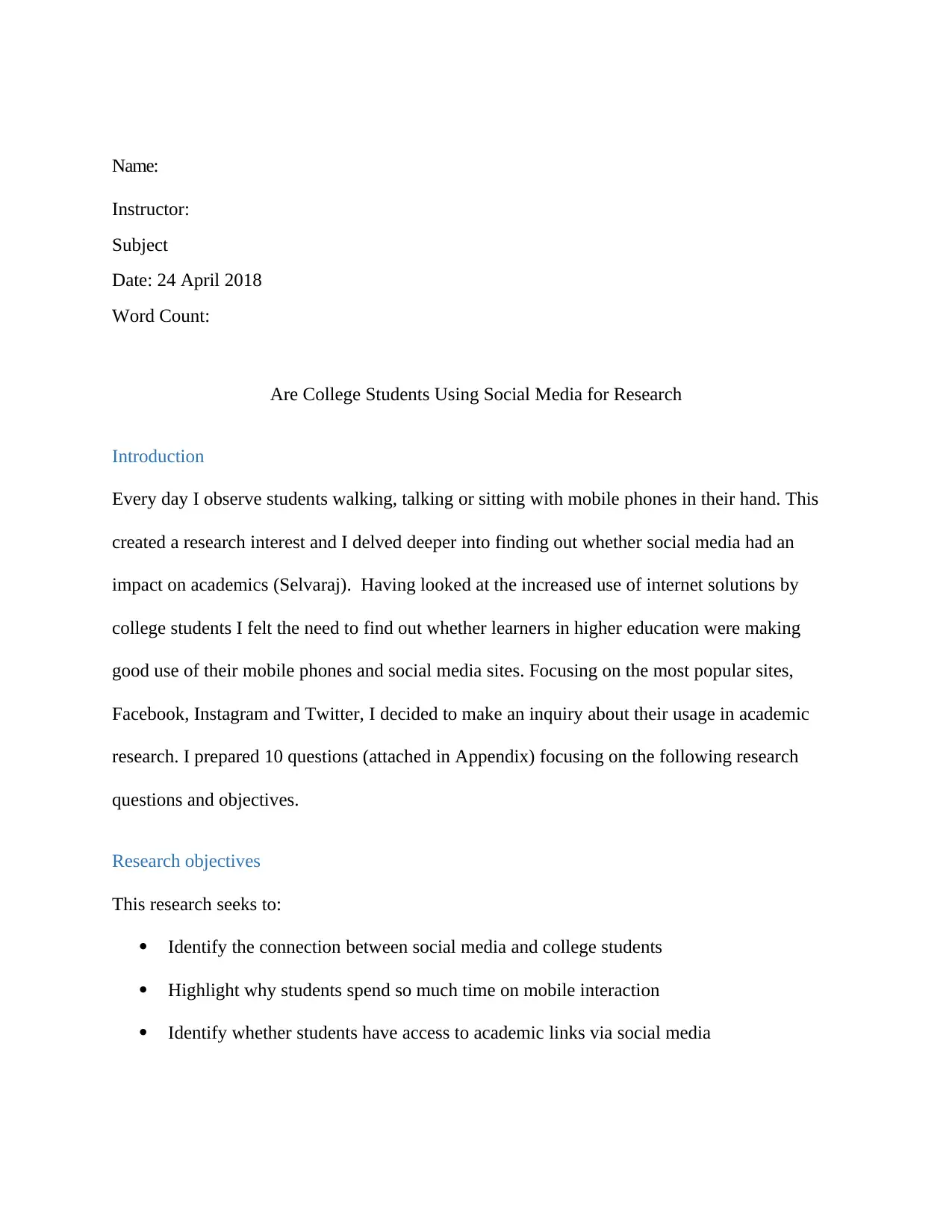
Name:
Instructor:
Subject
Date: 24 April 2018
Word Count:
Are College Students Using Social Media for Research
Introduction
Every day I observe students walking, talking or sitting with mobile phones in their hand. This
created a research interest and I delved deeper into finding out whether social media had an
impact on academics (Selvaraj). Having looked at the increased use of internet solutions by
college students I felt the need to find out whether learners in higher education were making
good use of their mobile phones and social media sites. Focusing on the most popular sites,
Facebook, Instagram and Twitter, I decided to make an inquiry about their usage in academic
research. I prepared 10 questions (attached in Appendix) focusing on the following research
questions and objectives.
Research objectives
This research seeks to:
Identify the connection between social media and college students
Highlight why students spend so much time on mobile interaction
Identify whether students have access to academic links via social media
Instructor:
Subject
Date: 24 April 2018
Word Count:
Are College Students Using Social Media for Research
Introduction
Every day I observe students walking, talking or sitting with mobile phones in their hand. This
created a research interest and I delved deeper into finding out whether social media had an
impact on academics (Selvaraj). Having looked at the increased use of internet solutions by
college students I felt the need to find out whether learners in higher education were making
good use of their mobile phones and social media sites. Focusing on the most popular sites,
Facebook, Instagram and Twitter, I decided to make an inquiry about their usage in academic
research. I prepared 10 questions (attached in Appendix) focusing on the following research
questions and objectives.
Research objectives
This research seeks to:
Identify the connection between social media and college students
Highlight why students spend so much time on mobile interaction
Identify whether students have access to academic links via social media
Paraphrase This Document
Need a fresh take? Get an instant paraphrase of this document with our AI Paraphraser
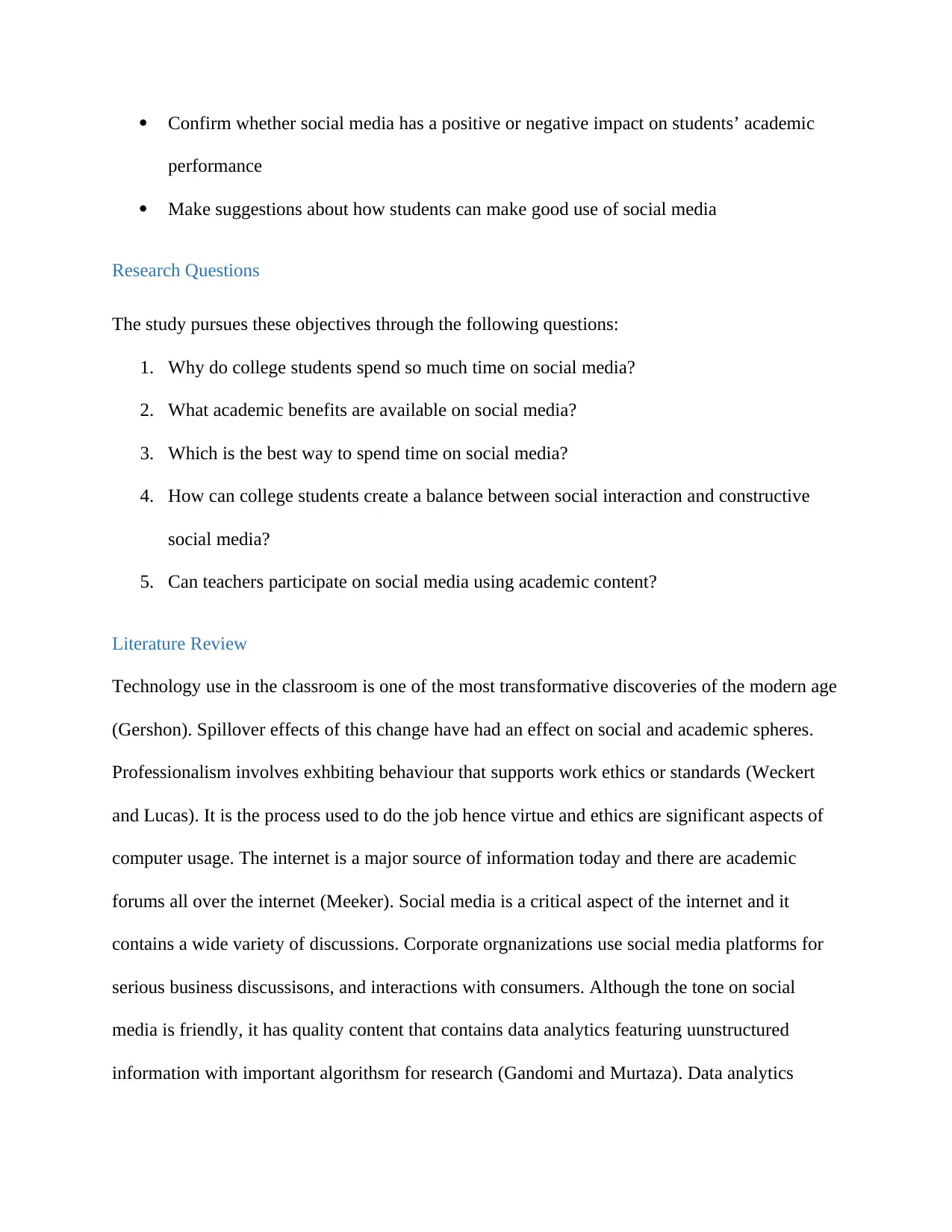
Confirm whether social media has a positive or negative impact on students’ academic
performance
Make suggestions about how students can make good use of social media
Research Questions
The study pursues these objectives through the following questions:
1. Why do college students spend so much time on social media?
2. What academic benefits are available on social media?
3. Which is the best way to spend time on social media?
4. How can college students create a balance between social interaction and constructive
social media?
5. Can teachers participate on social media using academic content?
Literature Review
Technology use in the classroom is one of the most transformative discoveries of the modern age
(Gershon). Spillover effects of this change have had an effect on social and academic spheres.
Professionalism involves exhbiting behaviour that supports work ethics or standards (Weckert
and Lucas). It is the process used to do the job hence virtue and ethics are significant aspects of
computer usage. The internet is a major source of information today and there are academic
forums all over the internet (Meeker). Social media is a critical aspect of the internet and it
contains a wide variety of discussions. Corporate orgnanizations use social media platforms for
serious business discussisons, and interactions with consumers. Although the tone on social
media is friendly, it has quality content that contains data analytics featuring uunstructured
information with important algorithsm for research (Gandomi and Murtaza). Data analytics
performance
Make suggestions about how students can make good use of social media
Research Questions
The study pursues these objectives through the following questions:
1. Why do college students spend so much time on social media?
2. What academic benefits are available on social media?
3. Which is the best way to spend time on social media?
4. How can college students create a balance between social interaction and constructive
social media?
5. Can teachers participate on social media using academic content?
Literature Review
Technology use in the classroom is one of the most transformative discoveries of the modern age
(Gershon). Spillover effects of this change have had an effect on social and academic spheres.
Professionalism involves exhbiting behaviour that supports work ethics or standards (Weckert
and Lucas). It is the process used to do the job hence virtue and ethics are significant aspects of
computer usage. The internet is a major source of information today and there are academic
forums all over the internet (Meeker). Social media is a critical aspect of the internet and it
contains a wide variety of discussions. Corporate orgnanizations use social media platforms for
serious business discussisons, and interactions with consumers. Although the tone on social
media is friendly, it has quality content that contains data analytics featuring uunstructured
information with important algorithsm for research (Gandomi and Murtaza). Data analytics
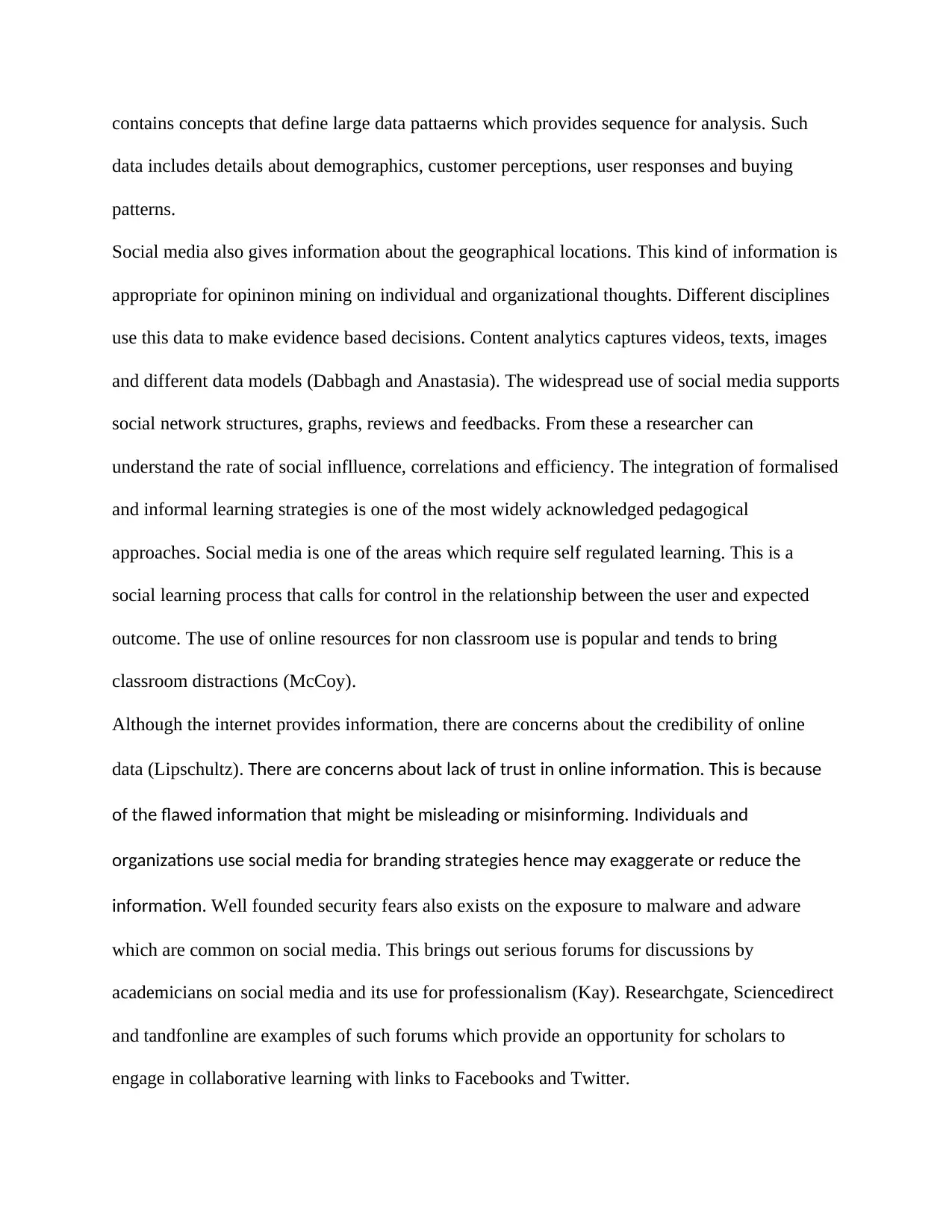
contains concepts that define large data pattaerns which provides sequence for analysis. Such
data includes details about demographics, customer perceptions, user responses and buying
patterns.
Social media also gives information about the geographical locations. This kind of information is
appropriate for opininon mining on individual and organizational thoughts. Different disciplines
use this data to make evidence based decisions. Content analytics captures videos, texts, images
and different data models (Dabbagh and Anastasia). The widespread use of social media supports
social network structures, graphs, reviews and feedbacks. From these a researcher can
understand the rate of social inflluence, correlations and efficiency. The integration of formalised
and informal learning strategies is one of the most widely acknowledged pedagogical
approaches. Social media is one of the areas which require self regulated learning. This is a
social learning process that calls for control in the relationship between the user and expected
outcome. The use of online resources for non classroom use is popular and tends to bring
classroom distractions (McCoy).
Although the internet provides information, there are concerns about the credibility of online
data (Lipschultz). There are concerns about lack of trust in online information. This is because
of the flawed information that might be misleading or misinforming. Individuals and
organizations use social media for branding strategies hence may exaggerate or reduce the
information. Well founded security fears also exists on the exposure to malware and adware
which are common on social media. This brings out serious forums for discussions by
academicians on social media and its use for professionalism (Kay). Researchgate, Sciencedirect
and tandfonline are examples of such forums which provide an opportunity for scholars to
engage in collaborative learning with links to Facebooks and Twitter.
data includes details about demographics, customer perceptions, user responses and buying
patterns.
Social media also gives information about the geographical locations. This kind of information is
appropriate for opininon mining on individual and organizational thoughts. Different disciplines
use this data to make evidence based decisions. Content analytics captures videos, texts, images
and different data models (Dabbagh and Anastasia). The widespread use of social media supports
social network structures, graphs, reviews and feedbacks. From these a researcher can
understand the rate of social inflluence, correlations and efficiency. The integration of formalised
and informal learning strategies is one of the most widely acknowledged pedagogical
approaches. Social media is one of the areas which require self regulated learning. This is a
social learning process that calls for control in the relationship between the user and expected
outcome. The use of online resources for non classroom use is popular and tends to bring
classroom distractions (McCoy).
Although the internet provides information, there are concerns about the credibility of online
data (Lipschultz). There are concerns about lack of trust in online information. This is because
of the flawed information that might be misleading or misinforming. Individuals and
organizations use social media for branding strategies hence may exaggerate or reduce the
information. Well founded security fears also exists on the exposure to malware and adware
which are common on social media. This brings out serious forums for discussions by
academicians on social media and its use for professionalism (Kay). Researchgate, Sciencedirect
and tandfonline are examples of such forums which provide an opportunity for scholars to
engage in collaborative learning with links to Facebooks and Twitter.
⊘ This is a preview!⊘
Do you want full access?
Subscribe today to unlock all pages.

Trusted by 1+ million students worldwide
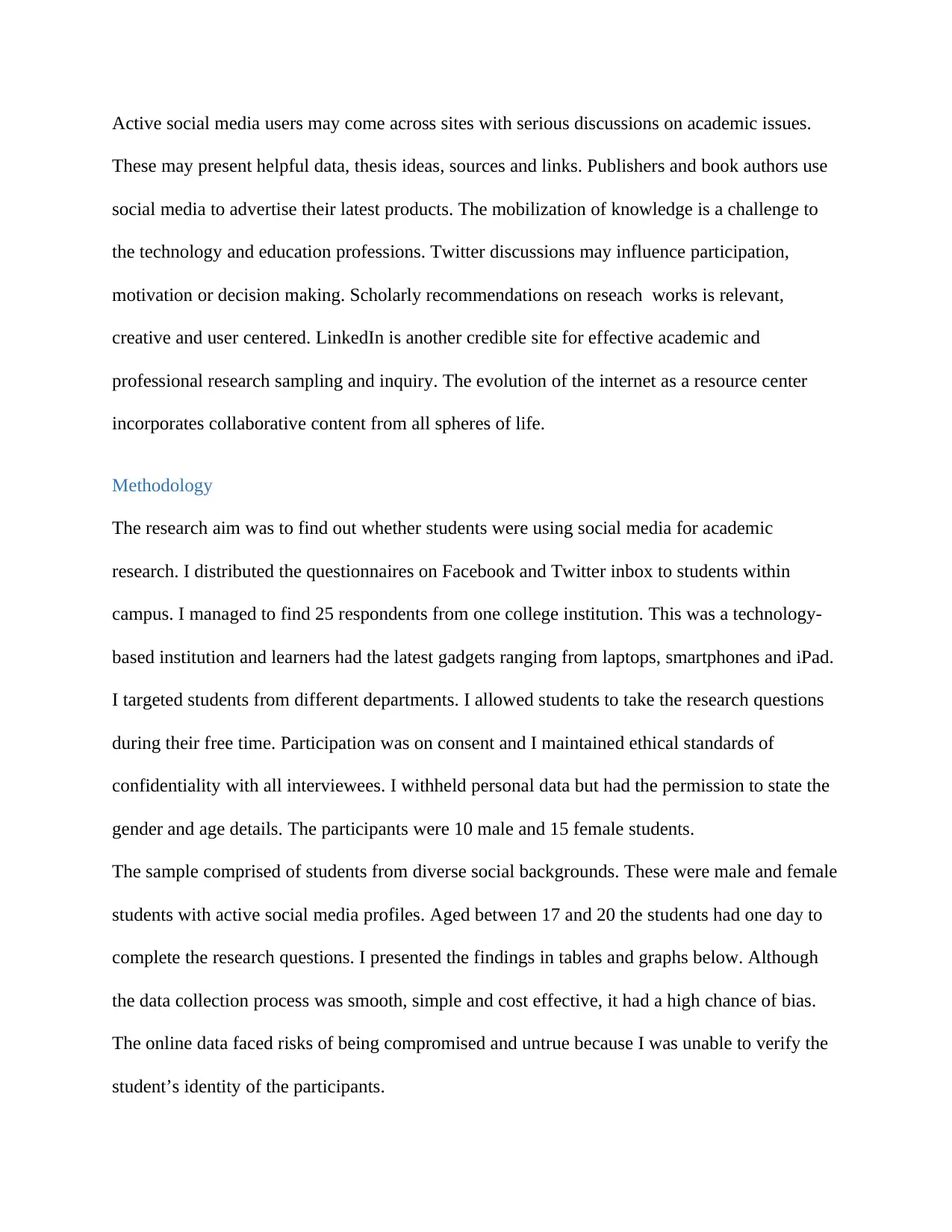
Active social media users may come across sites with serious discussions on academic issues.
These may present helpful data, thesis ideas, sources and links. Publishers and book authors use
social media to advertise their latest products. The mobilization of knowledge is a challenge to
the technology and education professions. Twitter discussions may influence participation,
motivation or decision making. Scholarly recommendations on reseach works is relevant,
creative and user centered. LinkedIn is another credible site for effective academic and
professional research sampling and inquiry. The evolution of the internet as a resource center
incorporates collaborative content from all spheres of life.
Methodology
The research aim was to find out whether students were using social media for academic
research. I distributed the questionnaires on Facebook and Twitter inbox to students within
campus. I managed to find 25 respondents from one college institution. This was a technology-
based institution and learners had the latest gadgets ranging from laptops, smartphones and iPad.
I targeted students from different departments. I allowed students to take the research questions
during their free time. Participation was on consent and I maintained ethical standards of
confidentiality with all interviewees. I withheld personal data but had the permission to state the
gender and age details. The participants were 10 male and 15 female students.
The sample comprised of students from diverse social backgrounds. These were male and female
students with active social media profiles. Aged between 17 and 20 the students had one day to
complete the research questions. I presented the findings in tables and graphs below. Although
the data collection process was smooth, simple and cost effective, it had a high chance of bias.
The online data faced risks of being compromised and untrue because I was unable to verify the
student’s identity of the participants.
These may present helpful data, thesis ideas, sources and links. Publishers and book authors use
social media to advertise their latest products. The mobilization of knowledge is a challenge to
the technology and education professions. Twitter discussions may influence participation,
motivation or decision making. Scholarly recommendations on reseach works is relevant,
creative and user centered. LinkedIn is another credible site for effective academic and
professional research sampling and inquiry. The evolution of the internet as a resource center
incorporates collaborative content from all spheres of life.
Methodology
The research aim was to find out whether students were using social media for academic
research. I distributed the questionnaires on Facebook and Twitter inbox to students within
campus. I managed to find 25 respondents from one college institution. This was a technology-
based institution and learners had the latest gadgets ranging from laptops, smartphones and iPad.
I targeted students from different departments. I allowed students to take the research questions
during their free time. Participation was on consent and I maintained ethical standards of
confidentiality with all interviewees. I withheld personal data but had the permission to state the
gender and age details. The participants were 10 male and 15 female students.
The sample comprised of students from diverse social backgrounds. These were male and female
students with active social media profiles. Aged between 17 and 20 the students had one day to
complete the research questions. I presented the findings in tables and graphs below. Although
the data collection process was smooth, simple and cost effective, it had a high chance of bias.
The online data faced risks of being compromised and untrue because I was unable to verify the
student’s identity of the participants.
Paraphrase This Document
Need a fresh take? Get an instant paraphrase of this document with our AI Paraphraser
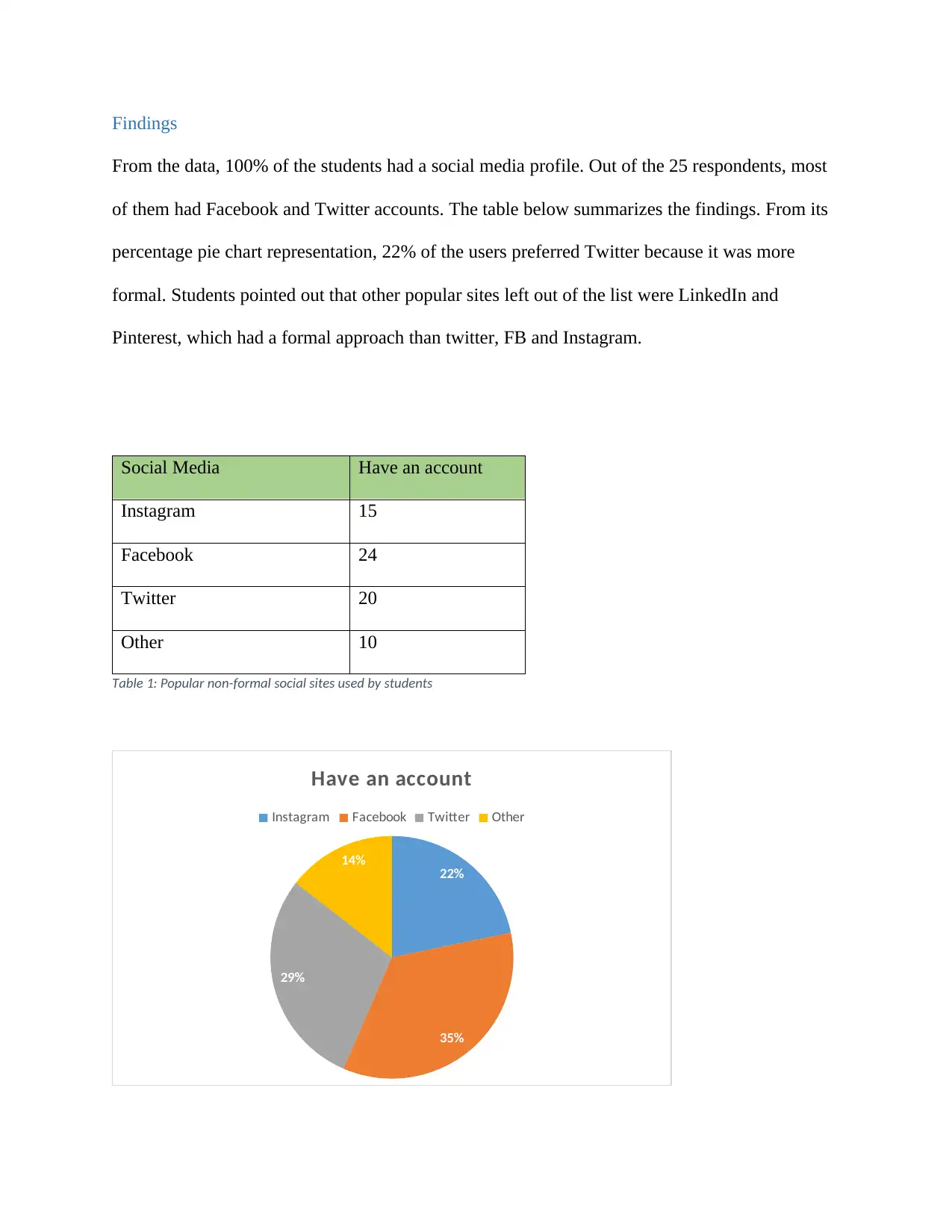
Findings
From the data, 100% of the students had a social media profile. Out of the 25 respondents, most
of them had Facebook and Twitter accounts. The table below summarizes the findings. From its
percentage pie chart representation, 22% of the users preferred Twitter because it was more
formal. Students pointed out that other popular sites left out of the list were LinkedIn and
Pinterest, which had a formal approach than twitter, FB and Instagram.
Social Media Have an account
Instagram 15
Facebook 24
Twitter 20
Other 10
Table 1: Popular non-formal social sites used by students
22%
35%
29%
14%
Have an account
Instagram Facebook Twitter Other
From the data, 100% of the students had a social media profile. Out of the 25 respondents, most
of them had Facebook and Twitter accounts. The table below summarizes the findings. From its
percentage pie chart representation, 22% of the users preferred Twitter because it was more
formal. Students pointed out that other popular sites left out of the list were LinkedIn and
Pinterest, which had a formal approach than twitter, FB and Instagram.
Social Media Have an account
Instagram 15
Facebook 24
Twitter 20
Other 10
Table 1: Popular non-formal social sites used by students
22%
35%
29%
14%
Have an account
Instagram Facebook Twitter Other
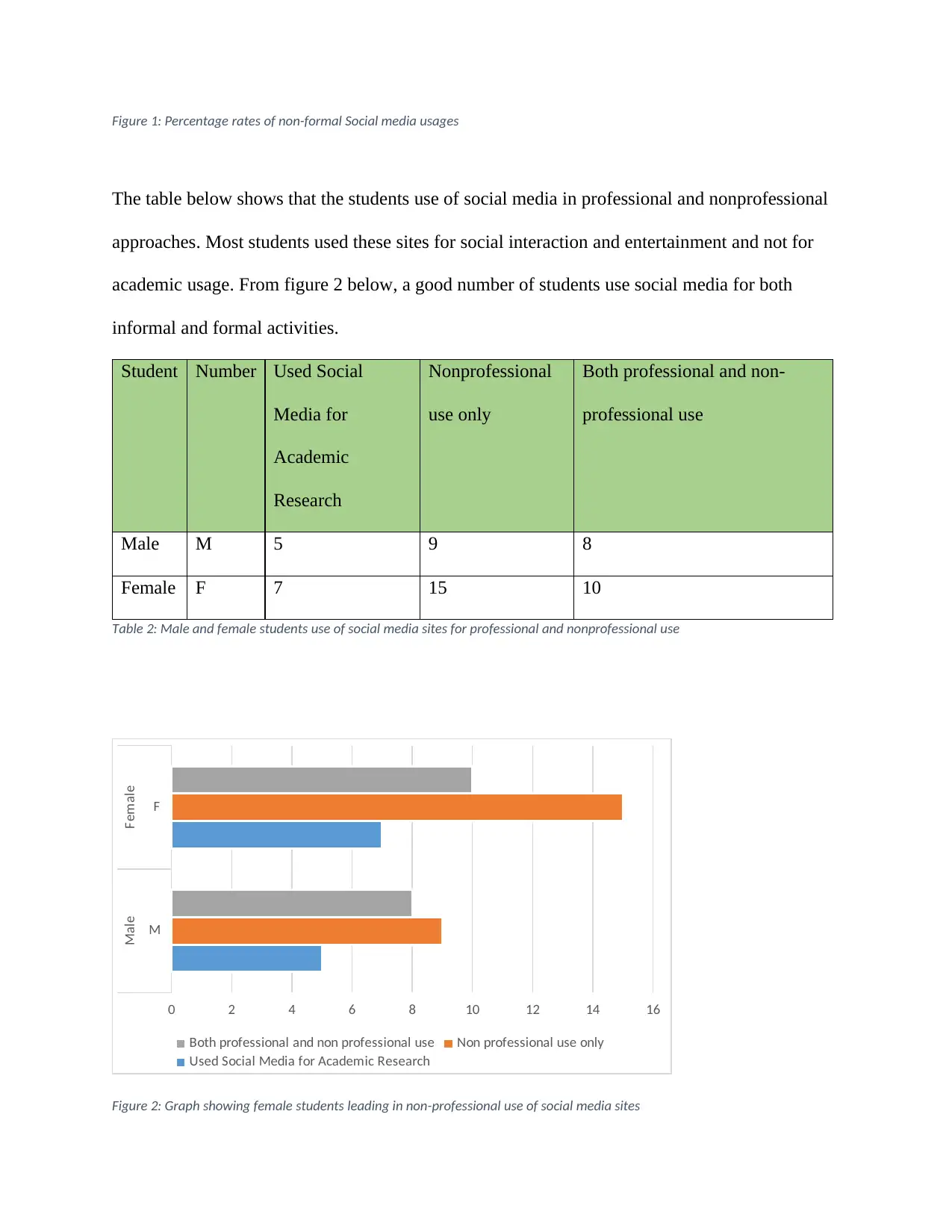
Figure 1: Percentage rates of non-formal Social media usages
The table below shows that the students use of social media in professional and nonprofessional
approaches. Most students used these sites for social interaction and entertainment and not for
academic usage. From figure 2 below, a good number of students use social media for both
informal and formal activities.
Student Number Used Social
Media for
Academic
Research
Nonprofessional
use only
Both professional and non-
professional use
Male M 5 9 8
Female F 7 15 10
Table 2: Male and female students use of social media sites for professional and nonprofessional use
M
F
Male Female
0 2 4 6 8 10 12 14 16
Both professional and non professional use Non professional use only
Used Social Media for Academic Research
Figure 2: Graph showing female students leading in non-professional use of social media sites
The table below shows that the students use of social media in professional and nonprofessional
approaches. Most students used these sites for social interaction and entertainment and not for
academic usage. From figure 2 below, a good number of students use social media for both
informal and formal activities.
Student Number Used Social
Media for
Academic
Research
Nonprofessional
use only
Both professional and non-
professional use
Male M 5 9 8
Female F 7 15 10
Table 2: Male and female students use of social media sites for professional and nonprofessional use
M
F
Male Female
0 2 4 6 8 10 12 14 16
Both professional and non professional use Non professional use only
Used Social Media for Academic Research
Figure 2: Graph showing female students leading in non-professional use of social media sites
⊘ This is a preview!⊘
Do you want full access?
Subscribe today to unlock all pages.

Trusted by 1+ million students worldwide
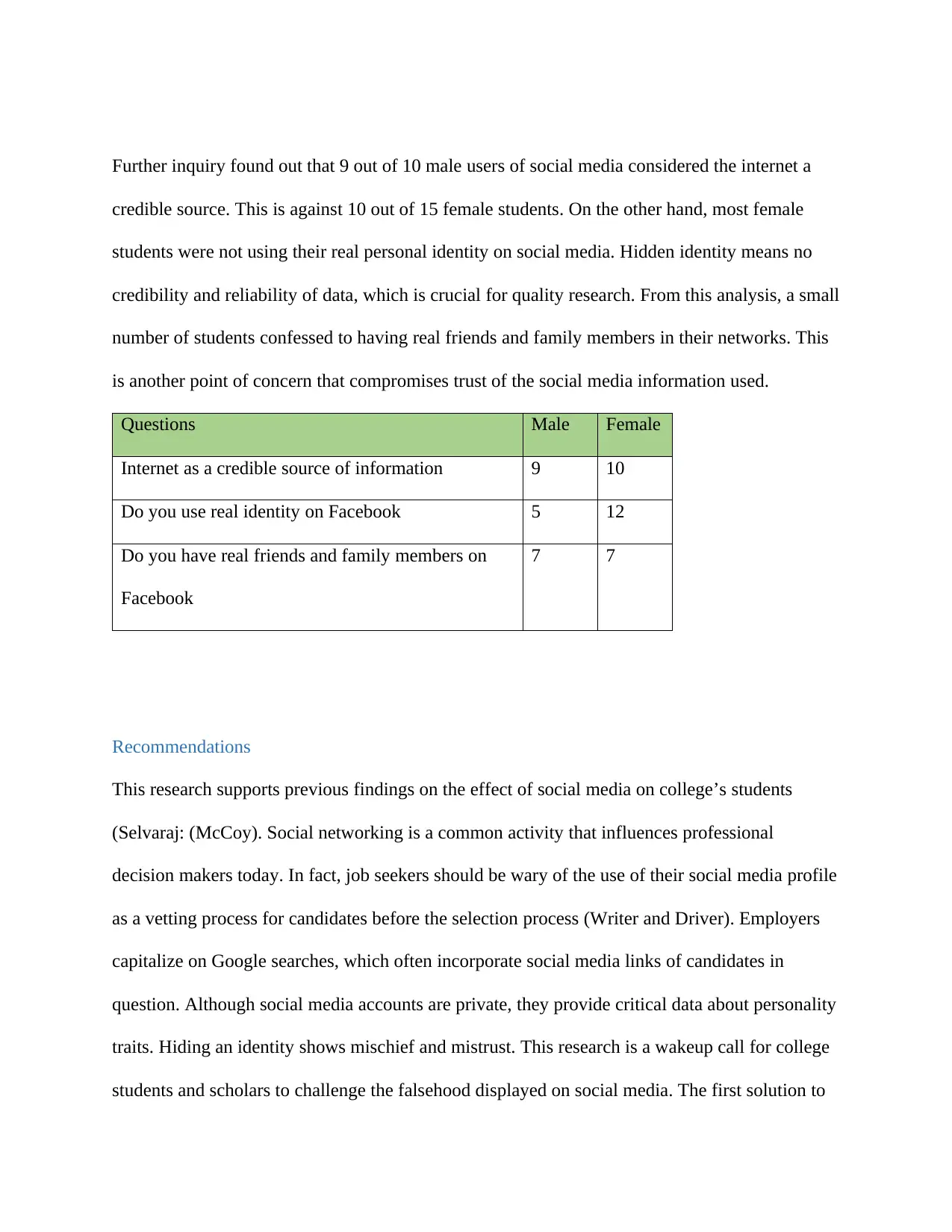
Further inquiry found out that 9 out of 10 male users of social media considered the internet a
credible source. This is against 10 out of 15 female students. On the other hand, most female
students were not using their real personal identity on social media. Hidden identity means no
credibility and reliability of data, which is crucial for quality research. From this analysis, a small
number of students confessed to having real friends and family members in their networks. This
is another point of concern that compromises trust of the social media information used.
Questions Male Female
Internet as a credible source of information 9 10
Do you use real identity on Facebook 5 12
Do you have real friends and family members on
Facebook
7 7
Recommendations
This research supports previous findings on the effect of social media on college’s students
(Selvaraj: (McCoy). Social networking is a common activity that influences professional
decision makers today. In fact, job seekers should be wary of the use of their social media profile
as a vetting process for candidates before the selection process (Writer and Driver). Employers
capitalize on Google searches, which often incorporate social media links of candidates in
question. Although social media accounts are private, they provide critical data about personality
traits. Hiding an identity shows mischief and mistrust. This research is a wakeup call for college
students and scholars to challenge the falsehood displayed on social media. The first solution to
credible source. This is against 10 out of 15 female students. On the other hand, most female
students were not using their real personal identity on social media. Hidden identity means no
credibility and reliability of data, which is crucial for quality research. From this analysis, a small
number of students confessed to having real friends and family members in their networks. This
is another point of concern that compromises trust of the social media information used.
Questions Male Female
Internet as a credible source of information 9 10
Do you use real identity on Facebook 5 12
Do you have real friends and family members on
7 7
Recommendations
This research supports previous findings on the effect of social media on college’s students
(Selvaraj: (McCoy). Social networking is a common activity that influences professional
decision makers today. In fact, job seekers should be wary of the use of their social media profile
as a vetting process for candidates before the selection process (Writer and Driver). Employers
capitalize on Google searches, which often incorporate social media links of candidates in
question. Although social media accounts are private, they provide critical data about personality
traits. Hiding an identity shows mischief and mistrust. This research is a wakeup call for college
students and scholars to challenge the falsehood displayed on social media. The first solution to
Paraphrase This Document
Need a fresh take? Get an instant paraphrase of this document with our AI Paraphraser
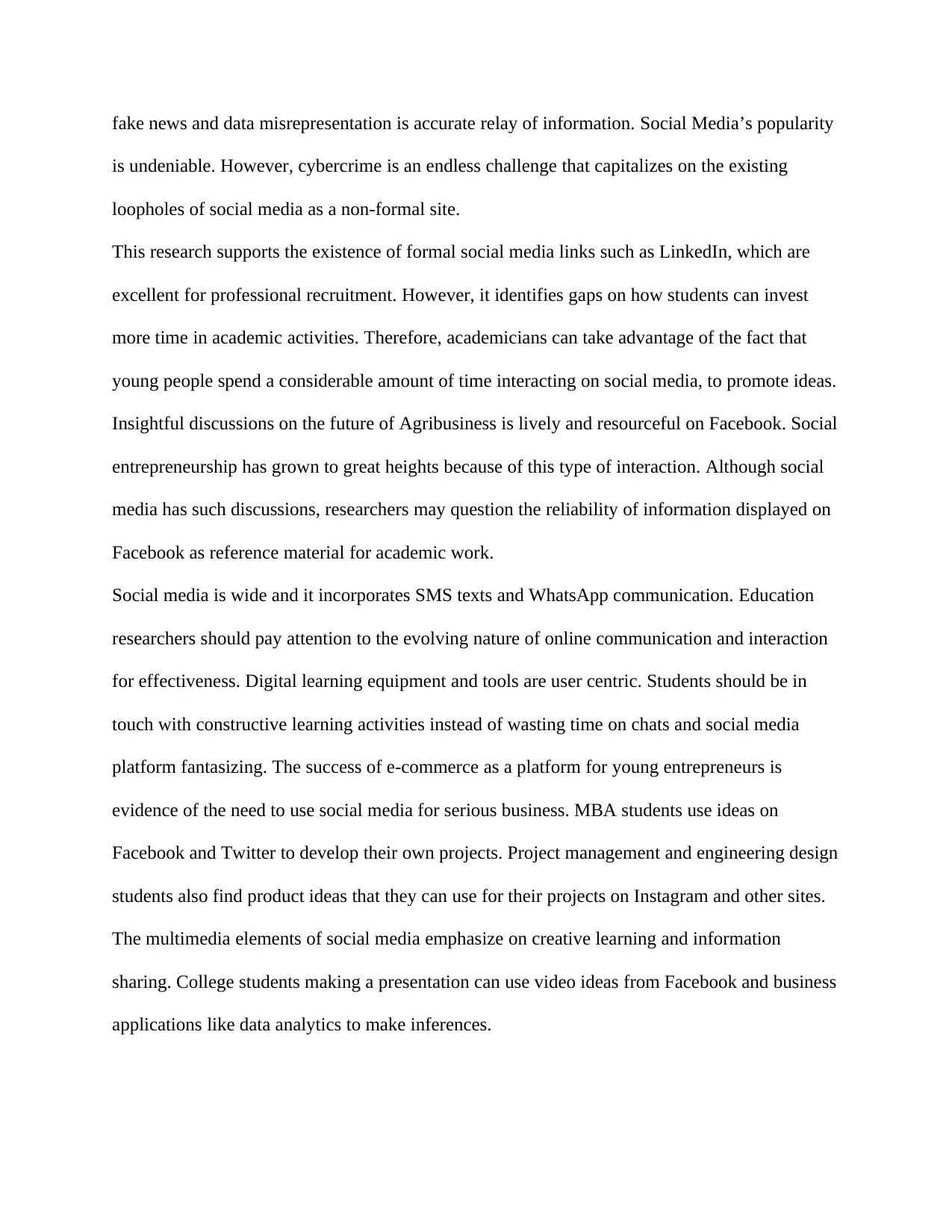
fake news and data misrepresentation is accurate relay of information. Social Media’s popularity
is undeniable. However, cybercrime is an endless challenge that capitalizes on the existing
loopholes of social media as a non-formal site.
This research supports the existence of formal social media links such as LinkedIn, which are
excellent for professional recruitment. However, it identifies gaps on how students can invest
more time in academic activities. Therefore, academicians can take advantage of the fact that
young people spend a considerable amount of time interacting on social media, to promote ideas.
Insightful discussions on the future of Agribusiness is lively and resourceful on Facebook. Social
entrepreneurship has grown to great heights because of this type of interaction. Although social
media has such discussions, researchers may question the reliability of information displayed on
Facebook as reference material for academic work.
Social media is wide and it incorporates SMS texts and WhatsApp communication. Education
researchers should pay attention to the evolving nature of online communication and interaction
for effectiveness. Digital learning equipment and tools are user centric. Students should be in
touch with constructive learning activities instead of wasting time on chats and social media
platform fantasizing. The success of e-commerce as a platform for young entrepreneurs is
evidence of the need to use social media for serious business. MBA students use ideas on
Facebook and Twitter to develop their own projects. Project management and engineering design
students also find product ideas that they can use for their projects on Instagram and other sites.
The multimedia elements of social media emphasize on creative learning and information
sharing. College students making a presentation can use video ideas from Facebook and business
applications like data analytics to make inferences.
is undeniable. However, cybercrime is an endless challenge that capitalizes on the existing
loopholes of social media as a non-formal site.
This research supports the existence of formal social media links such as LinkedIn, which are
excellent for professional recruitment. However, it identifies gaps on how students can invest
more time in academic activities. Therefore, academicians can take advantage of the fact that
young people spend a considerable amount of time interacting on social media, to promote ideas.
Insightful discussions on the future of Agribusiness is lively and resourceful on Facebook. Social
entrepreneurship has grown to great heights because of this type of interaction. Although social
media has such discussions, researchers may question the reliability of information displayed on
Facebook as reference material for academic work.
Social media is wide and it incorporates SMS texts and WhatsApp communication. Education
researchers should pay attention to the evolving nature of online communication and interaction
for effectiveness. Digital learning equipment and tools are user centric. Students should be in
touch with constructive learning activities instead of wasting time on chats and social media
platform fantasizing. The success of e-commerce as a platform for young entrepreneurs is
evidence of the need to use social media for serious business. MBA students use ideas on
Facebook and Twitter to develop their own projects. Project management and engineering design
students also find product ideas that they can use for their projects on Instagram and other sites.
The multimedia elements of social media emphasize on creative learning and information
sharing. College students making a presentation can use video ideas from Facebook and business
applications like data analytics to make inferences.
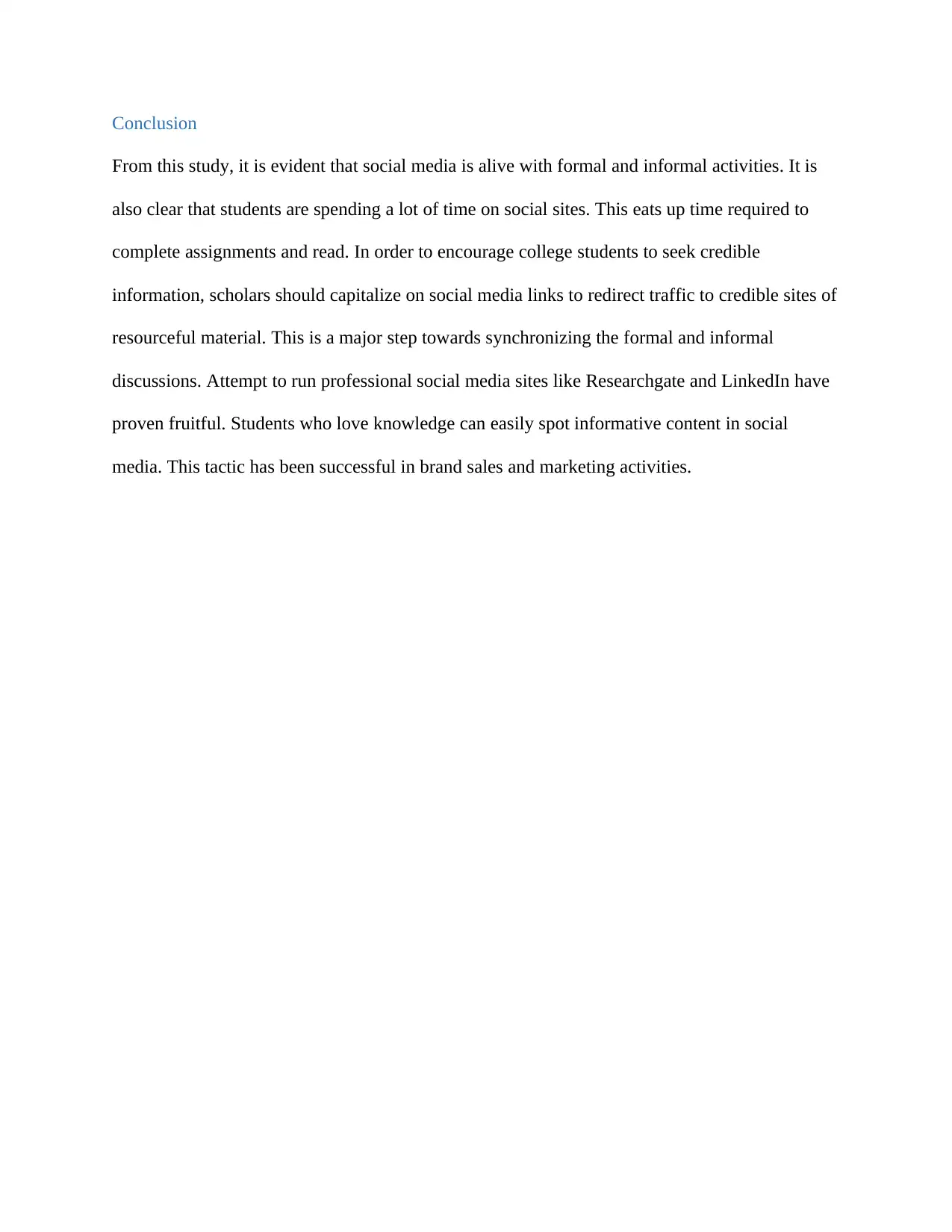
Conclusion
From this study, it is evident that social media is alive with formal and informal activities. It is
also clear that students are spending a lot of time on social sites. This eats up time required to
complete assignments and read. In order to encourage college students to seek credible
information, scholars should capitalize on social media links to redirect traffic to credible sites of
resourceful material. This is a major step towards synchronizing the formal and informal
discussions. Attempt to run professional social media sites like Researchgate and LinkedIn have
proven fruitful. Students who love knowledge can easily spot informative content in social
media. This tactic has been successful in brand sales and marketing activities.
From this study, it is evident that social media is alive with formal and informal activities. It is
also clear that students are spending a lot of time on social sites. This eats up time required to
complete assignments and read. In order to encourage college students to seek credible
information, scholars should capitalize on social media links to redirect traffic to credible sites of
resourceful material. This is a major step towards synchronizing the formal and informal
discussions. Attempt to run professional social media sites like Researchgate and LinkedIn have
proven fruitful. Students who love knowledge can easily spot informative content in social
media. This tactic has been successful in brand sales and marketing activities.
⊘ This is a preview!⊘
Do you want full access?
Subscribe today to unlock all pages.

Trusted by 1+ million students worldwide
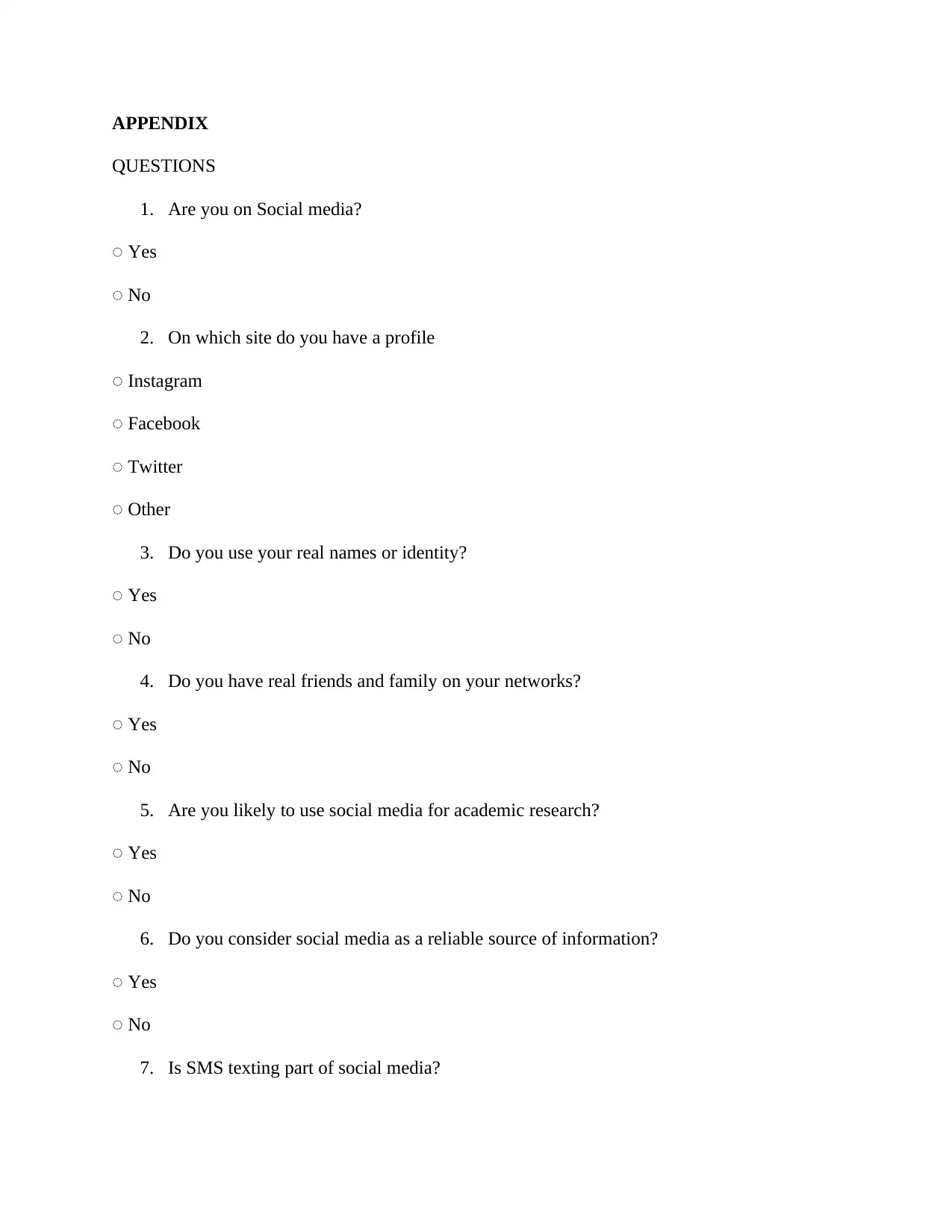
APPENDIX
QUESTIONS
1. Are you on Social media?󠆳
Yes󠆳
No
2. On which site do you have a profile󠆳
Instagram󠆳
Facebook󠆳
Twitter󠆳
Other
3. Do you use your real names or identity?󠆳
Yes󠆳
No
4. Do you have real friends and family on your networks?󠆳
Yes󠆳
No
5. Are you likely to use social media for academic research?󠆳
Yes󠆳
No
6. Do you consider social media as a reliable source of information?󠆳
Yes󠆳
No
7. Is SMS texting part of social media?
QUESTIONS
1. Are you on Social media?󠆳
Yes󠆳
No
2. On which site do you have a profile󠆳
Instagram󠆳
Facebook󠆳
Twitter󠆳
Other
3. Do you use your real names or identity?󠆳
Yes󠆳
No
4. Do you have real friends and family on your networks?󠆳
Yes󠆳
No
5. Are you likely to use social media for academic research?󠆳
Yes󠆳
No
6. Do you consider social media as a reliable source of information?󠆳
Yes󠆳
No
7. Is SMS texting part of social media?
Paraphrase This Document
Need a fresh take? Get an instant paraphrase of this document with our AI Paraphraser
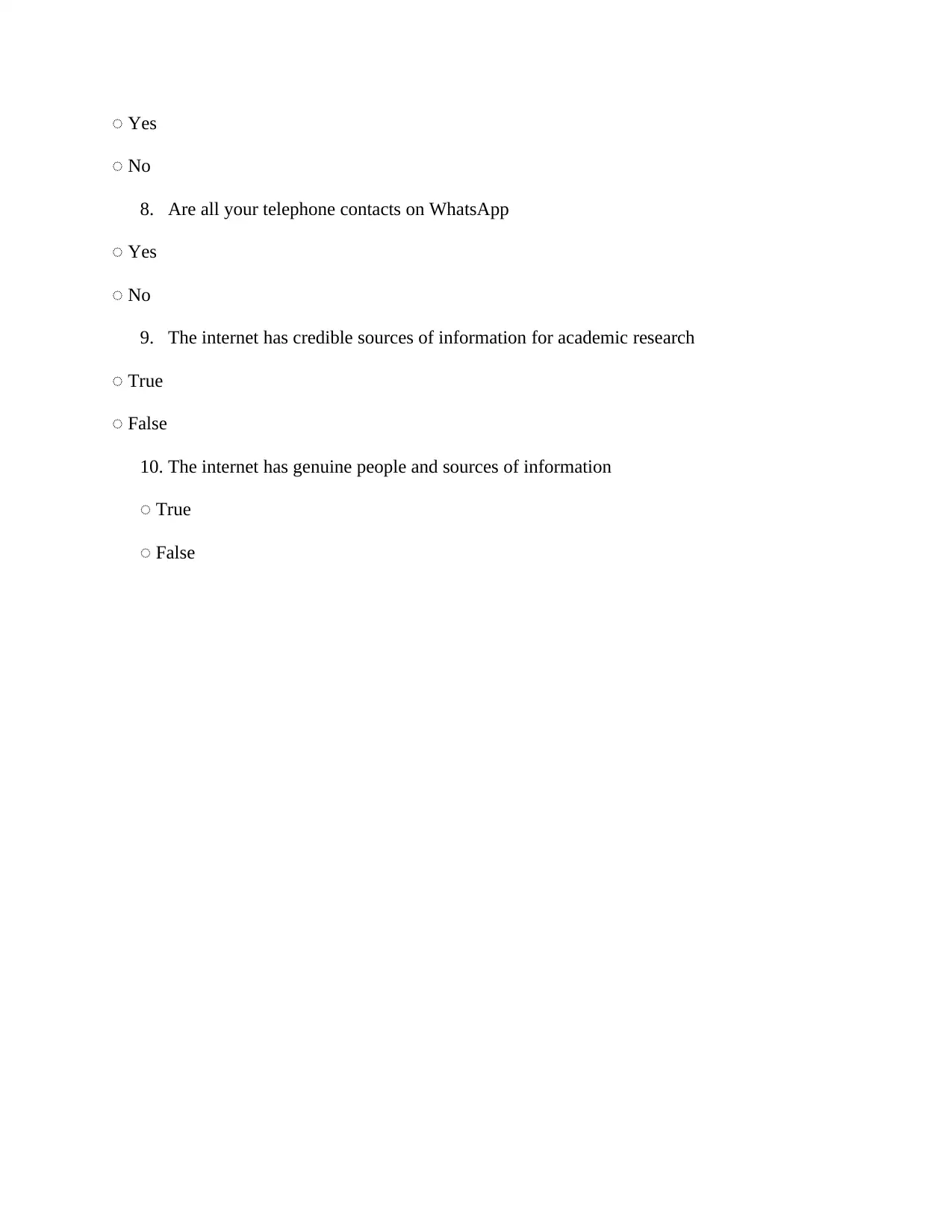
󠆳Yes󠆳
No
8. Are all your telephone contacts on WhatsApp󠆳
Yes󠆳
No
9. The internet has credible sources of information for academic research󠆳
True󠆳
False
10. The internet has genuine people and sources of information󠆳
True󠆳
False
No
8. Are all your telephone contacts on WhatsApp󠆳
Yes󠆳
No
9. The internet has credible sources of information for academic research󠆳
True󠆳
False
10. The internet has genuine people and sources of information󠆳
True󠆳
False
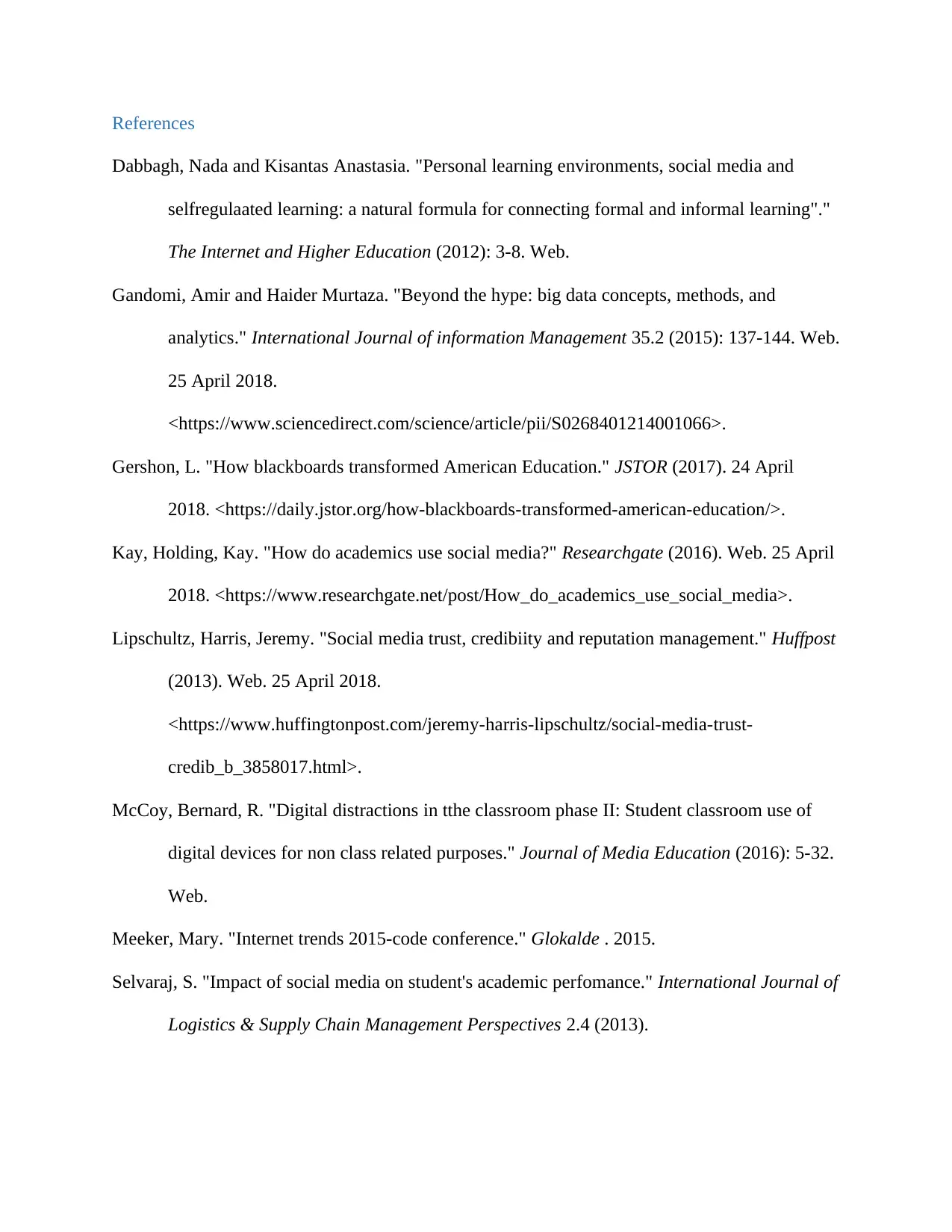
References
Dabbagh, Nada and Kisantas Anastasia. "Personal learning environments, social media and
selfregulaated learning: a natural formula for connecting formal and informal learning"."
The Internet and Higher Education (2012): 3-8. Web.
Gandomi, Amir and Haider Murtaza. "Beyond the hype: big data concepts, methods, and
analytics." International Journal of information Management 35.2 (2015): 137-144. Web.
25 April 2018.
<https://www.sciencedirect.com/science/article/pii/S0268401214001066>.
Gershon, L. "How blackboards transformed American Education." JSTOR (2017). 24 April
2018. <https://daily.jstor.org/how-blackboards-transformed-american-education/>.
Kay, Holding, Kay. "How do academics use social media?" Researchgate (2016). Web. 25 April
2018. <https://www.researchgate.net/post/How_do_academics_use_social_media>.
Lipschultz, Harris, Jeremy. "Social media trust, credibiity and reputation management." Huffpost
(2013). Web. 25 April 2018.
<https://www.huffingtonpost.com/jeremy-harris-lipschultz/social-media-trust-
credib_b_3858017.html>.
McCoy, Bernard, R. "Digital distractions in tthe classroom phase II: Student classroom use of
digital devices for non class related purposes." Journal of Media Education (2016): 5-32.
Web.
Meeker, Mary. "Internet trends 2015-code conference." Glokalde . 2015.
Selvaraj, S. "Impact of social media on student's academic perfomance." International Journal of
Logistics & Supply Chain Management Perspectives 2.4 (2013).
Dabbagh, Nada and Kisantas Anastasia. "Personal learning environments, social media and
selfregulaated learning: a natural formula for connecting formal and informal learning"."
The Internet and Higher Education (2012): 3-8. Web.
Gandomi, Amir and Haider Murtaza. "Beyond the hype: big data concepts, methods, and
analytics." International Journal of information Management 35.2 (2015): 137-144. Web.
25 April 2018.
<https://www.sciencedirect.com/science/article/pii/S0268401214001066>.
Gershon, L. "How blackboards transformed American Education." JSTOR (2017). 24 April
2018. <https://daily.jstor.org/how-blackboards-transformed-american-education/>.
Kay, Holding, Kay. "How do academics use social media?" Researchgate (2016). Web. 25 April
2018. <https://www.researchgate.net/post/How_do_academics_use_social_media>.
Lipschultz, Harris, Jeremy. "Social media trust, credibiity and reputation management." Huffpost
(2013). Web. 25 April 2018.
<https://www.huffingtonpost.com/jeremy-harris-lipschultz/social-media-trust-
credib_b_3858017.html>.
McCoy, Bernard, R. "Digital distractions in tthe classroom phase II: Student classroom use of
digital devices for non class related purposes." Journal of Media Education (2016): 5-32.
Web.
Meeker, Mary. "Internet trends 2015-code conference." Glokalde . 2015.
Selvaraj, S. "Impact of social media on student's academic perfomance." International Journal of
Logistics & Supply Chain Management Perspectives 2.4 (2013).
⊘ This is a preview!⊘
Do you want full access?
Subscribe today to unlock all pages.

Trusted by 1+ million students worldwide
1 out of 13
Related Documents
Your All-in-One AI-Powered Toolkit for Academic Success.
+13062052269
info@desklib.com
Available 24*7 on WhatsApp / Email
![[object Object]](/_next/static/media/star-bottom.7253800d.svg)
Unlock your academic potential
Copyright © 2020–2025 A2Z Services. All Rights Reserved. Developed and managed by ZUCOL.





